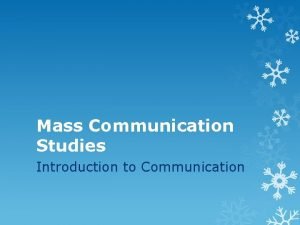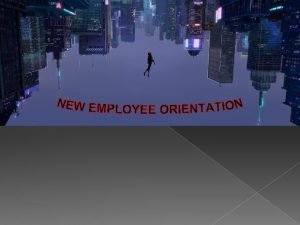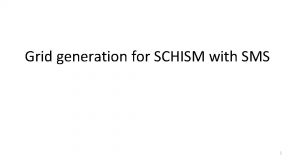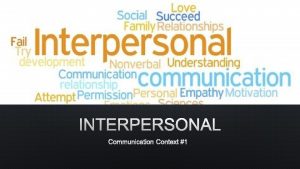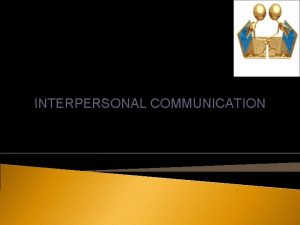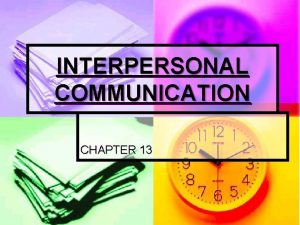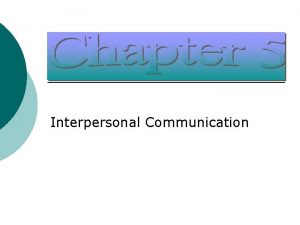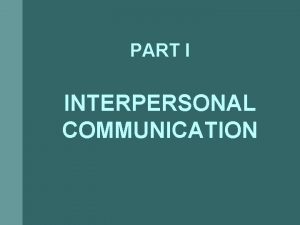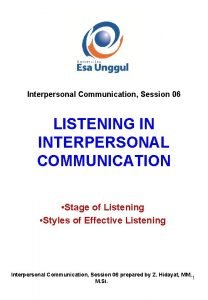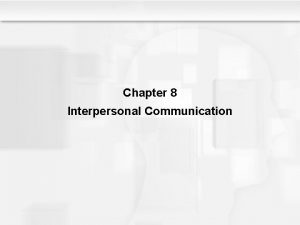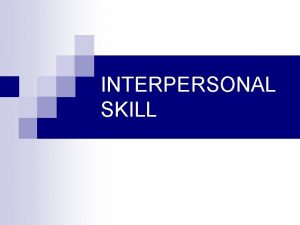INTERPERSONAL COMMUNICATION San Diego NITM 2015 WHY INTERPERSONAL




























- Slides: 28

INTERPERSONAL COMMUNICATION San Diego NITM 2015


WHY INTERPERSONAL COMMUNICATION? “Great leaders are almost always great simplifiers, who can cut through argument, debate, and doubt to offer a solution everybody can understand. ” — General Colin Powell “The single biggest problem in communication is the illusion that it has taken place. ” — George Bernard Shaw

AT YOUR TABLE, THINK ABOUT: ▪ What do I want to get out of this session? ▪ Write down your answers.

AGENDA Style (for you and others) § Perspective (thoughtful analysis) § Context and adaptability (what works when) § Channels (what forms it takes) §

STYLE Many ways to think about it ▪ Identify your style ▪ Start to apply new knowledge ▪

COMMUNICATING STYLES SURVEY Dr. Paul Mok, founder of CST and TAP ▪ Patented tool based on Carl Jung’s work ▪ Administered to 5+ million people in 5, 000+ organizations ▪ Used for training, development, conflict management, & team-building ▪

SURVEY INSTRUCTIONS ▪ ▪ ▪ Take and score your survey Don’t agonize; go with your gut feeling Rank: 6, 4, 3, 1 Score when you’re through Raise your hand for help

SURVEY SAYS… • • • It’s time to interpret your scores… but first: Everyone has all 4 styles No one style is better than another Self-assessment is subject to bias Can change depending on your conditions

RECORD YOUR SCORES ▪ Your style under favorable (normal) conditions Dominant ▪ Secondary ▪ ▪ Your style under stressful conditions Dominant ▪ Secondary ▪

DO YOU SEE YOURSELF?

GROUP EXERCISE Leave things at your table ▪ Get with others who share your type under stress ▪

GROUP EXERCISE Develop your “Top 5 Tips for Communicating with a _____” ▪ Please think quietly for a few minutes, then share with your group ▪ Record to flip charts ▪ Be ready to share your tips, on a flip chart, with full group ▪

TIME FOR A BREAK…


“TOP 5 TIPS” FOR EACH STYLE Report out ▪ Listen to each perspective ▪ Additions? ▪ Questions and discussion with full group ▪

PERSPECTIVE • The real payoff is in what you do with this information. Apply this to: • Observe • Categorize • Connect

DO YOU SEE OTHERS?

CONTEXT AND ADAPTABILITY ▪ The goal is to connect ▪ Connect by style-flexing ▪ Style-flex to be in-sync; not to manipulate ▪ Be conscious of strengthening a style

COMMUNICATION STYLE PLAN Goal: Reflect and apply ▪ Consider 2 -3 people you work with regularly ▪ Guess each person’s primary and backup styles ▪ How will you communicate with them differently? ▪

EXERCISE: THINK, PAIR, SHARE Think - Pair - Share around your communication style plan ▪ Provide feedback and switch ▪ Apply the perspective of others to your interactions with your colleagues ▪

WHERE ARE WE NOW? Style is pervasive… • Understand your strengths and blind spots • Develop skill so you can stretch to meet others •

YOUR ROLES MAY INCLUDE: ▪ ▪ ▪ Manager Technical lead Cross-functional team leader Peer coach What else?

YOUR CHANNELS MAY INCLUDE: ▪ ▪ ▪ One-on-one conversations Team meetings Large group presentations to your division Email message to campus What else?

APPLY STYLES TO YOUR COMMUNICATION CHANNELS ▪ Message. What are my messages? ▪ ▪ Which one is the most important? Audience. To whom am I talking? What keeps them up at night? ▪ Why do they care about my message? “WIIFM? ” ▪ ▪ Story. ▪ What will reach them--and bring them to my message?

REFLECT • Within 2 weeks… How will I begin? ▪ Who will I ask for support? ▪ The first thing I will do is: ▪ On what date will I review this? ▪

NEXT STEP: A GENTLE NUDGE 3 x 5 card ▪ Be specific ▪ Self-address an envelope ▪ Hand it in ▪

QUESTIONS?
 Sally nitm
Sally nitm Pictures
Pictures Interpersonal communication is contextual
Interpersonal communication is contextual What is mass communication
What is mass communication San diego continuing education north city campus
San diego continuing education north city campus Universal design san diego
Universal design san diego San diego pretrial services
San diego pretrial services San ysidro parentvue
San ysidro parentvue Mental health america of san diego county
Mental health america of san diego county Sarawagi san diego
Sarawagi san diego Switchvox san diego
Switchvox san diego Conchiglia movimento d'amore san juan diego
Conchiglia movimento d'amore san juan diego Sarawagi san diego
Sarawagi san diego Lemsis san diego
Lemsis san diego Rti zeromq
Rti zeromq Birdso scilympiad
Birdso scilympiad Mid coast corridor transit project
Mid coast corridor transit project Kaiser san diego family medicine residency
Kaiser san diego family medicine residency 446 alta road suite 5300
446 alta road suite 5300 San diego imperial swimming
San diego imperial swimming Switchvox san diego
Switchvox san diego Delta sigma theta san diego
Delta sigma theta san diego Workbench san diego
Workbench san diego Crossdressing san diego
Crossdressing san diego San diego restorative justice
San diego restorative justice San diego imperial swimming
San diego imperial swimming San diego housing commission
San diego housing commission Iia san diego
Iia san diego San diego sms satellites
San diego sms satellites



